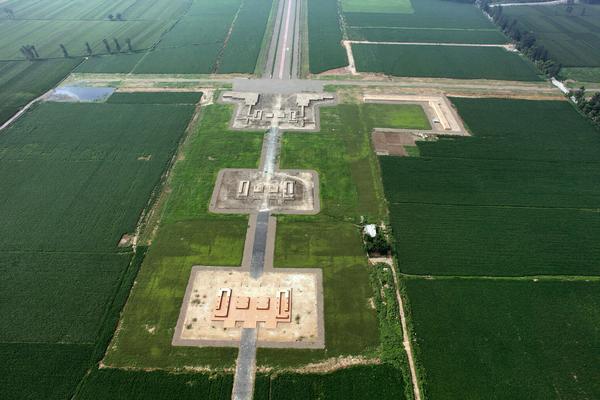Towards Civilization⑪|City ruins of Luoyang from Eastern Han to Northern Wei dynasties
"We should attach more importance to and put more efforts on archaeological research to carry forward the project of tracing the origins of Chinese civilization," stressed Chinese President Xi Jinping during his recent inspection tour to Anyang city, Henan province. Henan, cradle of the Chinese nation and civilization, is not only the birthplace of modern Chinese archaeology, but also the core area for tracing the origins of Chinese civilization. Together with the Development and Reform Commission of Henan Province and the Administration of Cultural Heritage of Henan Province, we are launching the "Towards Civilization" bilingual series featuring 13 key archaeological sites in Henan to help you catch a glimpse of wonderful Henan and brilliant Chinese civilization. Here is the 11th episode of the series: City ruins of Luoyang from Eastern Han to Northern Wei dynasties.
近日,习近平总书记考察了殷墟遗址,提出考古工作要继续重视和加强,继续深化中华文明探源工程。河南是中华民族和中华文明的重要发祥地,中国现代考古学从河南起步,中华文明探源从河南开始。2022年11月5日起,大河网联合省发展改革委、省文物局推出《追寻文明的足迹》系列报道,一起走进厚重河南。今日推出第十一期:《建中立极 千年阅一城——汉魏洛阳故城遗址》。
Click on the video above
Located on the Yiluo Plains some 15 kilometers east of today's Luoyang city are the almost 100-square-kilometer ruins of ancient Luoyang city, which was built in the Western Zhou Dynasty (1046-771 BC) and abandoned in the early Tang Dynasty (618-907). Once served as a capital of several dynasties for some 600 years, including the dynasties of Eastern Han (25-220), Cao Wei (220-266), Western Jin (265-317) and Northern Wei (386-534), the ancient city witnessed the rise and fall of dynasties, ethnic integration and cultural exchanges with other countries in ancient China, thus playing a significant role in the formation and development of a unified multi-ethnic country. Covering an area of about 100 square kilometers, it was probably the largest city ever seen in the world before modern times.
汉魏洛阳故城,位于今洛阳市东约15公里的伊洛平原上,总面积近100平方公里。汉魏故城始建于西周,东汉、曹魏、西晋、北魏等朝代相继为都,至唐初废弃,前后达1500年之久,其中光是作为都城时间就达600年,历经中国古代历史社会变革、民族融合、东西文化交流,在中华民族统一的多民族国家形成和发展历程中具有重要的历史地位和作用。汉魏洛阳故城长、宽均达10公里,可以说是近代以前世界范围内所见最大的城市。

Imperial palace. [Photo provided to dahe.cn]
With decades of efforts, archaeologists have gradually made clear the scale, development and layout of the city ruins. Its philosophy of "axial symmetry" in designing a capital's layout greatly influenced the later dynasties.
经过考古工作者数十年的不懈努力,城址规模、发展演变、空间格局等逐渐清晰。其开创的“中轴对称”都城形制,极大地影响了中国古代的都城面貌。(编译/赵汉青 播音/杨佳欣 视频/何蒙贺 审校/陈行洁)
Related stories
相关阅读
Towards Civilization①|Jiahu site, where Chinese civilization starts
Towards Civilization②|Yangshao village, birthplace of modern Chinese archaeology
Towards Civilization③|Miaodigou witnessed the prosperity of Yangshao Culture
追寻文明的足迹③|仰韶文化繁荣期的“文明之花”——庙底沟遗址
Towards Civilization④|Ancient 'Heluo Kingdom' in Gongyi, Henan
Towards Civilization⑤|Dahecun: a shining pearl of Yangshao Culture
Towards Civilization⑥|Discover earliest China at Erlitou site in Luoyang, Henan
Towards Civilization⑩|Capital city ruins of Eastern Zhou Dynasty in Luoyang
Towards Civilization⑫|City ruins of Luoyang from Sui to Tang dynasties
Towards Civilization⑬|Dongjing: An international metropolitan city during the Middle Ages
